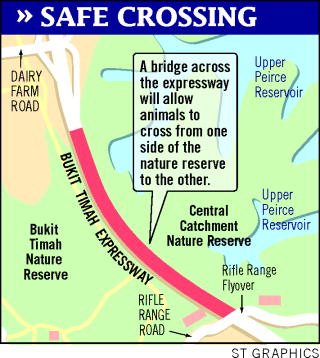
wild
places | wild happenings | wild
news
make a difference for our wild places
home | links | search the site
make a difference for our wild places
home | links | search the site
 |
wild
places | wild happenings | wild
news
make a difference for our wild places home | links | search the site |
| all articles latest | past | articles by topics | search wildnews |
|
wild
news on wildsingapore
|
| Straits
Times 11 Oct
07 Nature reserves may be reunited by eco-passage Green link will let wildlife move freely and preserve health of Bukit Timah and Central Catchment forests By Arti Mulchand  SEVERED
by the Bukit Timah Expressway for 22 years, the tracts of nature reserve
on either side of the highway may soon be rejoined - by an 'eco-passage',
or green bridge, to allow plant and animal species to cross over. SEVERED
by the Bukit Timah Expressway for 22 years, the tracts of nature reserve
on either side of the highway may soon be rejoined - by an 'eco-passage',
or green bridge, to allow plant and animal species to cross over. A government decision is expected soon to create such a stretch of vegetation. While it is not yet known where on the BKE this ecological corridor could be located, Dr Navjot Sodhi, a professor of conservation ecology at the National University of Singapore, says a logical spot would be where there is 'good forest' on both sides, with the two sides not far apart. The National Parks Board confirmed that it is exploring the eco-passage proposal with the Land Transport Authority to conserve Singapore's biodiversity. Conservationists had bemoaned the fact that the Bukit Timah Nature Reserve, a primary forest, was severed from the Central Catchment Nature Reserve when the BKE was completed in 1985. This prevented wildlife from criss-crossing the area in search of food and mates. Cross-pollination of plants, vital for genetic diversity, was also affected. But it made economic sense for the 10-km expressway, which starts at the PIE in Bukit Timah and travels north to the Woodlands Checkpoint and the Johor-Singapore Causeway, to go straight through the area, the authorities had said. But the BKE left the Bukit Timah side a virtual island, bound by roads, a railway, housing and a rifle range, and divided it from its hinterland, the Central Catchment Nature Reserve, a source of seeds and breeding partners. As a result, the long-term survival of the two fragmented forests was compromised, said Dr Geh Min, president of the Nature Society Singapore and a former Nominated MP, who had raised the issue in Parliament in 2005. Dr Sodhi, who has studied effects of extreme forest fragmentation on the bird community here, stressed that lower genetic diversity within a fragment could lead to lower reproductive success, and hence possible species lost. Animals which attempted to reach the other side by crossing the BKE have also wound up as roadkill. No formal study has yet been done to document what species may already have been lost. But globally, forest fragmentation's impact has been studied, and has led to the creation of eco-passages. Holland, for example, is home to one of the world's longest wildlife 'bridges', an 800m passage connecting a forest near Hilversum to the Bussum Moorland. But such eco-passages can be expensive, say experts. Issues like choice of an overpass or tunnel also need to be considered. Birds, monkeys and lemurs, for example, are more likely to use an overpass, while a tunnel will be good for ground dwellers. Plants and trees native to both sides and familiar to the animals will have to be incorporated to ensure the extension of the current habitat. The foliage has to be thick and function as a highway buffer for the animals too. These caveats aside, many conservationists are already cheered that policy-makers are now sensitive to the need to conserve biodiversity. And an eco-passage's success here could have an impact beyond Singapore, said Ms Ilsa Sharp, who wrote a book on the ecology and biology of Bukit Timah Nature Reserve with botanist Shawn Lum. She said: 'If Singapore can show that it can be done, similar to the re-growth of mangroves at Pulau Semakau, it will be a trailblazer for other countries with the same problem.' links More about Bukit Timah Nature Reserve Related articles on Singapore: biodiversity |
| News articles are reproduced for non-profit educational purposes. | |
website©ria tan 2003 www.wildsingapore.com |